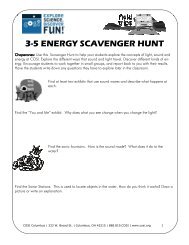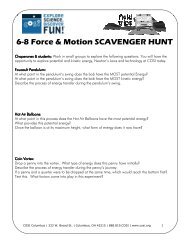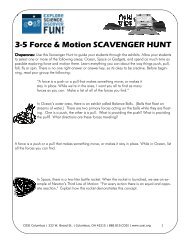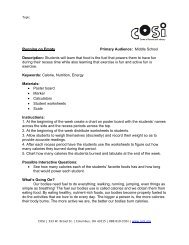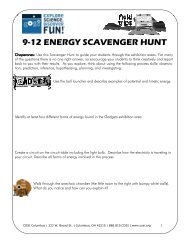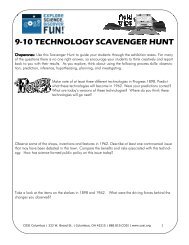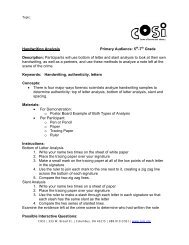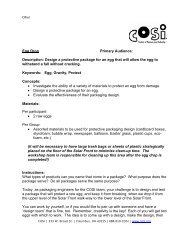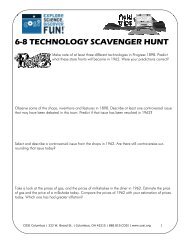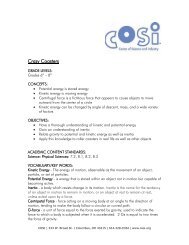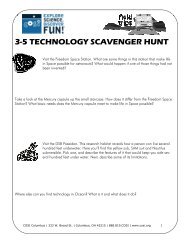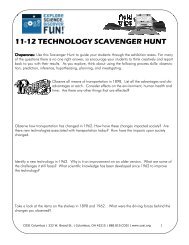3-5 Force & Motion TEACHER GUIDE - COSI
3-5 Force & Motion TEACHER GUIDE - COSI
3-5 Force & Motion TEACHER GUIDE - COSI
Create successful ePaper yourself
Turn your PDF publications into a flip-book with our unique Google optimized e-Paper software.
3-5 <strong>Force</strong> & <strong>Motion</strong> <strong>TEACHER</strong> <strong>GUIDE</strong>SPACEHow big is the universe? What drives humanity to the stars? These are questions that havepiqued the curiosity of many, and whose answers change as we gain more information about theuniverse. Space offers opportunities to think about these questions while at the same time relivesome of history's great space explorations. Enter the exhibit through the Black Hole, a cool spinningsensory experience, or sit in the Living Room and watch the history of space travel. Pleaseask students to use caution in the tunnel.• Overhead Thrusters Listen for the hissing sound. This is the sound of air being pushed throughthe thruster’s nozzles, causing thrust. Thrust is the primary means of acceleration in space. Inspace, propellant is pushed through a nozzle instead of air. Thrust from the air being forcedthrough the nozzles causes the thruster to move. The thruster has inertia. Inertia refers to anobject’s tendency to keep moving or the resistance to changes in motion. Until an outsideforce (air resistance, friction, collision) acts upon the thruster, it will continue to move. Thesethrusters will eventually stop on their own due to drag. The primary forces are air resistance(drag) and friction. In space, however, there is little gas, which means, little drag. To stop athruster here or in space, apply thrust in opposite direction. How do Newton’s laws of motionrelate to this exhibit? Newton’s first law of motion (objects in motion tend to stay in motion)explains why the thruster continues to fly after the thrust is disengaged. The thruster will continueto fly until some force opposes that motion. Newton’s second law (force = mass * acceleration)dictates the rate at which the thruster will accelerate when a force is applied eitherfrom thrust or air friction. Newton’s third law (every action has an equal and opposite reaction)is demonstrated by the simultaneous push the thruster exerts on the fuel (air) and pushthe fuel exerts on the thruster.• The Rocket Launch exhibit invites guests to "fuel up" a rocket by charging a projectile withcompressed air. Guests then perform their own countdown and release the miniature rocket,watching it arc 25 feet up to the ceiling. Rockets go because of Newton’s Third Law: For everyaction there is an equal and opposite reaction. Spent fuel escapes the rocket through a holecalled the nozzle. This is the action. The rocket moves away from the spent fuel, in effect pushingagainst it. This is the reaction. The more spent fuel the rocket leaves behind, and the fasterthe spent fuel moves, the faster the rocket will fly. Notice that the rocket does not push againstthe launch pad, the air, or anything else except its own fuel. This is the reason rockets canwork in outer space.<strong>COSI</strong> Columbus | 333 W. Broad St. | Columbus, OH 43215 | 888.819.<strong>COSI</strong> | www.cosi.org 5



